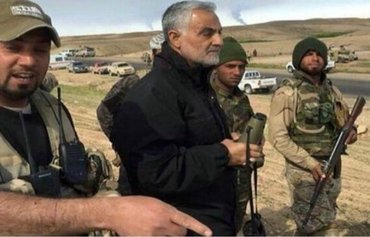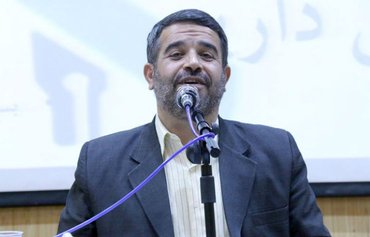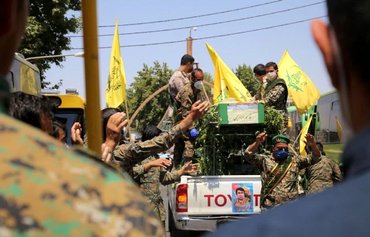The Iranian regime believes it was victorious in the battle for Aleppo and has attempted to reinforce this with official statements issued after the Syrian city fell to militias led by its Islamic Revolutionary Guard Corps (IRGC), experts told Diyaruna.
Iran's interference, represented by its presence in several parts of Syria, including Aleppo, will inflame sectarian divisions both in Syria and the region, they said
In several widely circulated photographs and re-circulated videos, elite Quds Force commander Qassem Soleimani is seen touring Aleppo and its citadel -- a series of images that clearly reveals Iran’s direct involvement in Syria.
Several leading Iranian figures also released statements hailing the victory.
Ali Akbar Velayati, Iranian World Assembly of Islamic Awakening secretary general and top foreign policy advisor to Iran's supreme leader, said the "victory" in Aleppo will change many "regional equations".
"Today, in view of the resistance forces’ victory and recapture of Aleppo, we once again see a manifest conquest," said IRGC deputy commander Hossein Salami.
Iranian Defence Minister Brig. Gen. Hossein Dehghan described the "victories" of the Syrian regime and its allies in Aleppo as "an important point in the war led by the axis of resistance against terrorists and extremists".
Iran sought gains, not peace
"In following the events that took place in the city of Aleppo, starting with its siege by IRGC-affiliated militias and some Syrian regular army soldiers, we can ascertain that Iran was determined to see any ceasefire fail and to continue the violent fighting," said al-Sharq Centre for Regional and Strategic Studies researcher Fathi al-Sayed, who specialises in Iranian affairs.
"Reports from Aleppo confirmed that [IRGC]-affiliated militias foiled the evacuation process more than once, to tie the process to gains it wanted to achieve in other areas," he told Diyaruna.
The Iranian regime held up the evacuation of Aleppo by insisting that civilians in the opposition-held villages of Fuaa and Kefraya be evacuated first, he said.
This was "an extension of the Iranian theatrical play aimed at portraying the intervention of Iran and its militias as a sacred religious war that aims to protect and rescue Shia from the attack they are under from Sunni militias", he added.
The deliberate violations of the truce in Aleppo not only serves to extend the war in Syria, al-Sayed said, but it also emboldens extremist groups, particularly al-Nusra Front (ANF), now known as Fatah al-Sham Front, and the "Islamic State of Iraq and the Levant" (ISIL), to continue their atrocities towards civilians.
The UN's Commission of Inquiry for Syria said on December 14th it had received reports that opposition fighters, including ANF militants, were blocking civilians from fleeing Aleppo, using them as human shields .
The IRGC's interference in the Syria truce "will give a pretext to these groups" to keep carrying out their terrorist operations as a means of retaliation against the Iran's support of the Syrian regime, he said.
The Iranian regime's determination to retake Aleppo is significant on many levels, al-Sayed said, noting that the city was the centre of global media and political attention.
"It seemed that whoever controls the city also controls the Syrian arena," he said, adding that "the Iranian statements that followed the fall of Aleppo undoubtedly aimed to spread the message that Iran’s intervention is no longer covert but is rather through direct military presence".
Iran has sought to expand its influence in the region "by means of the sectarian militias it has planted in these countries, led by the Lebanese Hizbullah party, the Quds Force, Iraq's Harakat al-Nujaba militia and others", he said.
The IRGC has become an instrument of instability in these areas because of that control , he added, which is closer to an occupation and will cause constant unrest and tension in the coming period.
Direct involvement in Syria
"The battle of Aleppo has many implications, including confirmation of Iran's direct involvement in the Syrian war," political researcher Abdul Nabi Bakkar told Diyaruna.
This was evident after the fall of eastern Aleppo and the statements made by IRGC commanders, he said, in addition to Soleimani's public appearances in the streets of Aleppo.
The IRGC seeks to promote that "Iran was victorious in the Aleppo war, which it is trying to portray as the end of the Syrian crisis", he said.
The Iranian statements issued upon the fall of Aleppo to IRGC-backed militias sought to portray it as "a major religious victory", said Cairo University doctoral student Sheyar Turko, who has been researching the financing of the IRGC.
This is because "Iran continues its sectarian mobilisation in the region to affirm its deployment as a supporter and protector of the Shia and Alawite", he told Diyaruna.
"The Aleppo victory is just another episode of the Iranian expansion in Syria, which is naturally tied to the Iranian proliferation in the Middle East," he said.
The IRGC was determined to achieve victory in Aleppo, Turko said, as it urgently needed an "added incentive to boost the morale of the armed groups it leads in the Syrian war".
Additionally, he said, the Iranian regime's quick declaration of victory sets the outline of the future of the Aleppo region, in which an Iranian presence will link Aleppo with Latakia, Damascus and rural Damascus.
The Iranian regime is trying to establish a belt to protect Damascus and "ensure its long term presence by propping up the head of state who is allied with it", Turko said.

![Elite Quds Force commander Maj. Gen. Qassem Soleimani (left) tours eastern Aleppo in this widely circulated photograph. [Photo circulating on social media]](/cnmi_di/images/2017/01/05/6976-qasem_soleimani-_aleppo-600_384.jpg)






